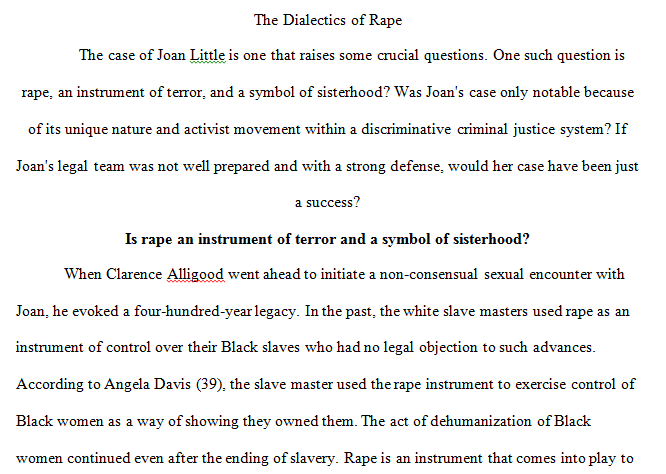Readings & Self-Generated Reading Questions
Week 3 Readings & Self-Generated Reading Questions
Read: All Our Trials, Ch. 1, “Lessons in Self-Defense,” p. 15-54
Extra Reading (not required): “Joan Little: The Dialectics of Rape,” by Angela Davis (Links to an external site.)
Reading Questions: Develop THREE compound questions based on the reading from this chapter. You may craft your questions based on anything that sparks you in the reading. Some examples might probe aspects of the feminist lens of the writer, the of intersectionality of the prison coalitions, what was at stake for the campaigns for the four women highlighted in the chapter, how the writer builds up the history of the multiple grassroots actions, how each figure became part of the campaign for her freedom, etc.
Here are some example of chapter highlights that can be incorporated into questions, including a couple quotations that might provide a base for a compound question:
Use of the term “self-defense” as more than a legal strategy that galvanized and transected social movements of the 1970s (17).
Prisoner defense campaigns emerged as a key mode of activism as a result of escalating attacks by COINTELPRO (24).
Framing the Joanne Little case as paramount to a women’s right agenda vs the “everywoman analysis” which obscured the particular social, political, and historical conditions of her case (31).
Problems inherent with framing rape primarily as an object of criminal justice (32).
Public support for Little was rare among while feminist women in North Carolina (33).
Rhetoric of colonial violence and “internal colonialism” (40).
Envisioning community self-defense as a militant, collective alternative to reliance on the police (45).
Discourses of “self-defense for women” and “racist and political repression” interacted and influence one another (49).
“The defense movement drew upon and extended a long history of black women’s antirape activism, and veteran organizers from previous struggle participated directly in the Little campaign” (22).
“These mobilizations functioned as coalition spaces where multiple liberation movements interfaced and cross-fertilized. Indeed, defense organizing provided key opportunities for developing coalition consciousness and practice” (53–from conclusion).
Read: All Our Trials, Ch. 1, “Lessons in Self-Defense,” p. 15-54
Extra Reading (not required): “Joan Little: The Dialectics of Rape,” by Angela Davis (Links to an external site.)
Reading Questions: Develop THREE compound questions based on the reading from this chapter. You may craft your questions based on anything that sparks you in the reading. Some examples might probe aspects of the feminist lens of the writer, the of intersectionality of the prison coalitions, what was at stake for the campaigns for the four women highlighted in the chapter, how the writer builds up the history of the multiple grassroots actions, how each figure became part of the campaign for her freedom, etc.
Here are some example of chapter highlights that can be incorporated into questions, including a couple quotations that might provide a base for a compound question:
Use of the term “self-defense” as more than a legal strategy that galvanized and transected social movements of the 1970s (17).
Prisoner defense campaigns emerged as a key mode of activism as a result of escalating attacks by COINTELPRO (24).
Framing the Joanne Little case as paramount to a women’s right agenda vs the “everywoman analysis” which obscured the particular social, political, and historical conditions of her case (31).
Problems inherent with framing rape primarily as an object of criminal justice (32).
Public support for Little was rare among while feminist women in North Carolina (33).
Rhetoric of colonial violence and “internal colonialism” (40).
Envisioning community self-defense as a militant, collective alternative to reliance on the police (45).
Discourses of “self-defense for women” and “racist and political repression” interacted and influence one another (49).
“The defense movement drew upon and extended a long history of black women’s antirape activism, and veteran organizers from previous struggle participated directly in the Little campaign” (22).
“These mobilizations functioned as coalition spaces where multiple liberation movements interfaced and cross-fertilized. Indeed, defense organizing provided key opportunities for developing coalition consciousness and practice” (53–from conclusion).
Helpful Acronyms from Ch. 1, “Lessons in Self-Defense”
AFW—Action for Forgotten Women
AIM—American Indian Movement
CCR—Center for Constitutional Rights
COINTELPRO—FBI Counterintelligence Program
FJP—Attica Fair Jury Project
IGDC—Inez Garcia Defense Committee
LEAA—Law Enforcement Assistance Administration
NAACP—National Association for the Advancement of Colored People
NAARPR—National Alliance Against Racist and Political Repression
NCCCW—North Carolina Correctional Center for Women
NCDDW—National Committee to Defend Dessie Woods
NOW—National Organization of Women
RCC—Rape Crisis Centers
TALF—Triangle Area Lesbian Feminists
TWWA—Third World Women’s Alliance
WARN—Women of All Red Nations
Solution preview for the order on readings & Self-Generated Reading Questions
APA
881 words

